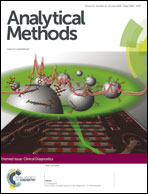Determination of illegal dyes in Salvia miltiorrhiza Bunge by matrix solid phase dispersion and ultrafast liquid chromatography†
Abstract
A simple, rapid and effective extraction method based on matrix solid phase dispersion (MSPD) and ultrafast liquid chromatographic (UFLC) was developed and validated for the simultaneous cleaning-up and quantitative extraction of illegal dyes (Sudan I–IV) from the roots of Salvia miltiorrhiza Bunge. The experiment parameters, such as dispersing sorbent, the ratio of sorbent–sample, washing solvent and elution solvent were evaluated to find the optimal MSPD conditions. The optimal conditions were 0.5 g of Salvia miltiorrhiza Bunge, 1.0 g of silica gel as dispersing sorbent, a volume of 10 mL of water as the washing solvent and 4 mL of acetonitrile–methanol (9 : 1, v/v) as the elution solvent. Under these conditions good linearity for all the Sudan dyes ranged from 0.10 μg g−1 to 10 μg g−1 (r2 ≥ 0.9992). The recoveries at three spiked levels (0.1, 1.0, 5.0 μg g−1) were between 80.6% and 96.1% with relative deviations (RSDs) ranging from 2.3% to 8.6%. The limits of detection ranged between 0.013 and 0.024 μg g−1 which were twenty times lower than the values required by European regulations. This method has potential to be applied for the determination of illegal dyes in complicated traditional Chinese herb materials.


 Please wait while we load your content...
Please wait while we load your content...